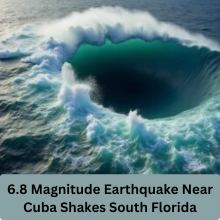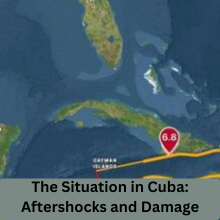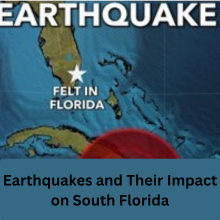
On Sunday, a powerful 6.8 magnitude earthquake struck off the coast of eastern Cuba, sending shockwaves not only through the island but also across the waters to nearby South Florida. This natural disaster adds to the mounting challenges faced by the island nation, which is still reeling from recent hurricanes and widespread blackouts. As the quake rattled eastern Cuba, residents in South Florida, particularly in Miami, were left concerned about the safety of their loved ones on the island, leading to an outpouring of worry and solidarity.
In this article, we’ll take a closer look at the impact of this earthquake, the reactions from both Cuba and South Florida, and what it means for the future of disaster preparedness in the region.
The 6.8 Magnitude Earthquake Near Cuba
What Happened?
The earthquake struck on Sunday morning, with its epicenter located approximately 25 miles south of Bartolome Maso, a small municipality in eastern Cuba. The magnitude of the tremor measured a significant 6.8 on the Richter scale, a force strong enough to cause substantial damage in the affected areas. The tremor was felt across a large portion of eastern Cuba, including major cities like Santiago de Cuba, Holguin, and Guantánamo.
The earthquake occurred just one hour after a slightly smaller 5.9 magnitude quake had already shaken the region, compounding the anxiety and fear felt by local residents.
Understanding the Scale: Why a 6.8 Magnitude Matters
A 6.8 magnitude earthquake is considered strong enough to cause serious structural damage to buildings, disrupt power supplies, and even result in casualties. In areas close to the epicenter, this level of seismic activity can lead to landslides, infrastructure collapse, and major disruptions to daily life. For context, the higher the magnitude of an earthquake, the more severe its potential effects, especially in densely populated or poorly constructed areas.
Emotional Shockwaves Felt in South Florida
The Reaction in Miami
In Miami, a city that is geographically close to Cuba and home to many Cuban-Americans, the emotional impact of the earthquake was immediate. Many South Floridians tried to contact relatives on the island, but communication was hampered by widespread blackouts and damage to telecommunications infrastructure in Cuba. A woman interviewed outside the iconic Versailles restaurant in Miami expressed her concern: “I can’t get through to my family. The power is probably out, and there’s no way to reach them right now.”
While there were no reports of significant physical damage in South Florida, the emotional toll was palpable. For many in Miami, Cuba is not just a neighboring island—it’s home, and the fear for the safety of family members living there was overwhelming.
Why South Florida Residents Are Concerned
South Florida has a long history of connections to Cuba, both cultural and familial. The region is home to a large Cuban-American population, many of whom have relatives living in the areas most affected by natural disasters. The earthquake, following on the heels of recent hurricanes, sparked renewed anxiety about the safety and well-being of those still living in Cuba under difficult circumstances.
In addition to the earthquake, the area has faced power outages and flooding due to hurricanes, further exacerbating the stress residents in South Florida feel when their loved ones are in danger.
The Situation in Cuba: Aftershocks and Damage
Damage Reported in Cuba
Cuban authorities have confirmed significant damage across various regions, particularly in the eastern provinces. Several buildings in Granma Province have been reported to have cracks in their walls, and debris has been scattered across the streets. The municipality of Pilón, in particular, has suffered extensive damage, with reports of collapsed homes and toppled power lines. Cuban President Miguel Díaz-Canel acknowledged the severity of the damage, stating that recovery efforts were underway.
Power Outages and Blackouts in Cuba
The earthquake has only added to the ongoing power crisis in Cuba. After recent hurricanes, many parts of the island have been without electricity for extended periods. The national power grid has been severely strained, and the earthquake has caused further disruptions, making it even harder for Cubans to access basic services and stay connected with the outside world.
A History of Natural Disasters in the Region
Recent Hurricanes and Their Impact
In the weeks leading up to the earthquake, Cuba had already been dealing with the effects of two powerful hurricanes—Hurricane Oscar and Hurricane Rafael. These storms left a trail of destruction in their wake, causing widespread power outages, flooding, and property damage. Hurricane Rafael, in particular, was a Category 3 storm that struck the western part of Cuba, compounding the already difficult situation for the island’s residents.
Why Cuba is Vulnerable to Natural Disasters
Cuba’s geographical location makes it particularly susceptible to natural disasters. The island is situated in the Caribbean, which is frequently affected by hurricanes, earthquakes, and other seismic activity. The lack of modern infrastructure and limited resources for disaster recovery further compounds the challenges faced by the Cuban people during times of crisis.
Earthquakes and Their Impact on South Florida
How Earthquakes Affect Florida
While South Florida is not typically known for experiencing major earthquakes, the proximity of the region to Cuba makes it vulnerable to seismic events. Earthquakes that occur off the coast of Cuba can cause tremors that reach as far as Miami, where buildings may sway and people can feel the ground rumbling. Fortunately, South Florida is not as seismically active as other regions, but the risk is still present.
The Earthquake’s Impact on Florida’s Infrastructure
Although South Florida did not experience significant damage from the earthquake, the event raises important questions about the resilience of the region’s infrastructure. Miami, for instance, has many older buildings that may not be able to withstand the effects of a major earthquake. While the area has hurricane preparedness plans, earthquake preparedness remains a relatively low priority, despite the proximity of the region to seismic zones.
What Happens After an Earthquake?
Immediate Reactions: How Authorities Respond
After an earthquake, local authorities and emergency services are usually the first to respond. In the case of Cuba, teams have been dispatched to assess the damage, rescue survivors, and begin clearing debris. The Cuban government has also been in contact with international organizations for assistance.
Recovery and Rehabilitation Efforts
Recovery from a large earthquake can take weeks or even months. In addition to restoring power and water supplies, Cuba will need to rebuild homes, roads, and infrastructure. It is crucial for both local authorities and international partners to work together to ensure that aid reaches those who need it most.
Can South Florida Be Affected by a Tsunami?
Understanding Tsunami Risks After an Earthquake
While the 6.8 magnitude earthquake near Cuba did not trigger a significant tsunami, it is important to understand the risks posed by such events. The US National Tsunami Warning Center issued a statement assuring that the earthquake did not present a significant threat to coastal regions. However, small tsunami waves could still be possible in areas closer to the epicenter.
Preparedness for Tsunamis in South Florida
South Florida is no stranger to the threat of hurricanes and storm surges, but tsunami preparedness is less emphasized. Residents should be aware of evacuation routes and emergency procedures should a tsunami warning ever be issued.
Also read: Walmart’s Black Friday Deal: 75-Inch 4K Roku TV for $378
Emotional and Psychological Effects of Earthquakes
How Disasters Affect Mental Health
Disasters like earthquakes can take a significant emotional toll on individuals and communities. The anxiety of living through such events, or even just feeling the tremors from a distance, can lead to heightened stress and mental health issues.
Community Support and Coping Strategies
In the aftermath of disasters, communities often come together to support one another. In South Florida, local organizations have offered resources for those affected by the emotional strain of the earthquake. Mental health professionals are also working to provide counseling and coping strategies for those dealing with anxiety or fear.
Also read: GSK Leaves BIO in 2025: Why Biotech Giants Are Leaving
Keeping in Touch with Family and Loved Ones During Crises
Communication Challenges in Cuba
With blackouts affecting much of Cuba, staying in touch with family members becomes a challenge. Many people in South Florida are relying on social media or satellite phones to contact their loved ones, although delays and difficulties remain common.
How Technology Helps During Crises
Despite the challenges, technology plays an important role in crisis communication. Social media platforms like Twitter and Facebook have been used to share updates on the situation in Cuba and to coordinate aid efforts.
How Can Residents of South Florida Prepare for Future Earthquakes?
Personal Earthquake Preparedness Tips
While earthquakes are less common in South Florida, it’s important to be prepared. Simple steps like securing heavy furniture, having an emergency kit, and knowing evacuation routes can help individuals stay safe in the event of an earthquake.
Building and Infrastructure Preparedness
For South Florida to be truly prepared for the possibility of seismic activity, building codes may need to be updated to ensure that structures are earthquake-resistant. This is especially important for older buildings and those located near the coast.
Conclusion
As Cuba continues to recover from both the earthquake and the devastating effects of recent hurricanes, South Florida residents remain on edge, worried about their loved ones and the potential for future seismic events. This earthquake serves as a reminder of the need for better disaster preparedness and stronger infrastructure in both Cuba and South Florida. In the face of natural disasters, communities must come together to support one another, and governments must ensure that recovery efforts are swift and effective.
FAQs
-
What caused the 6.8 magnitude earthquake near Cuba?
- The earthquake was caused by tectonic shifts along the fault lines off the coast of Cuba. Earthquakes in this region are typically a result of plate movement in the Caribbean.
-
Is South Florida at risk of major earthquakes?
- While South Florida is not as seismically active as other regions, it is still possible to feel tremors from earthquakes occurring off the coast of Cuba.
-
What are the potential long-term effects of this earthquake on Cuba?
- The long-term effects include rebuilding homes, restoring power and water supplies, and addressing the psychological toll on residents.
-
Should South Floridians worry about tsunamis after this earthquake?
- Although the earthquake did not produce a significant tsunami threat, there is always a small risk of tsunami waves in coastal areas near the epicenter.
-
How can I help my family in Cuba after the earthquake?
- Stay informed through social media and news outlets, and try using satellite phones or internet-based messaging apps to reach loved ones. Additionally, consider donating to humanitarian organizations providing aid to Cuba.

